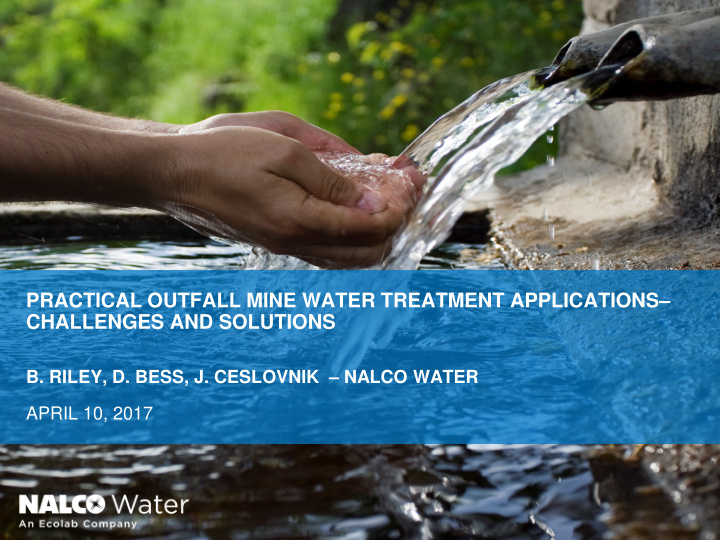



PRACTICAL OUTFALL MINE WATER TREATMENT APPLICATIONS– CHALLENGES AND SOLUTIONS B. RILEY, D. BESS, J. CESLOVNIK – NALCO WATER APRIL 10, 2017
Water is a critical business driver for mining and a shared scarce resource globally Producers face many water challenges • Regulatory landscape • Limited discharge options • Public perception • Environmental stewardship • Water shortages, variable water quality Economic climate drives the need to increase efficiencies and reduce total cost of operation without major capital expenditure Producers need solutions that • Are adaptable • Function in harsh and variable environments • Utilize available water (sea, waste, etc) • Are compatible with process applications
Mineral processing is water intensive – detailed understanding of all water flows and interactions is needed
Total Plant Approach to Water – Areas of Impact In-Process Water Reuse Water Effluent Water and Pretreatment Treatment Treatment Minimization • Seawater and • Process water • Tailings • Mine influenced slurry pipeline scale control management waters treatment corrosion control • Flotation • Water • Metals • Raw water optimization reuse/recycle removal treatment • Boiler and • Dust control • Sulfate • RO membrane cooling water reduction treatment treatment • Suspended solids • Mine dewatering Poor effluent treatment = negative environmental impact and substantial penalties for exceedances 4
Increasing scrutiny from regulatory agencies for multiple outlet parameters More and more sites needing active • discharge treatment in Appalachian coal areas Challenging applications - steep • runoffs, highly variable flows and limited holding volume/time Onsite/Bench testing critical for • effective program development • Feedpoint optimization critical • Options to improve residence time • Flocculant addition can improve settling • Ongoing monitoring and analytical testing • Flexible program for continued success Nalco has treatment solutions which have been proven effective for NPDES outlet parameters
Properly developed treatment programs able to meet discharge limits in most applications
7897 “Fish Friendly” Raw vs. Treated Raw : Treated @ 25 ppm
Common problems seen in the region include iron and turbidity • Site out of compliance with iron and turbidity • Staining creek below – had to pay for cleaning • Nalco Water program with pH adjustment, coagulant and flocculant • Iron solids dropped out and all NPDES guidelines met • Annual savings from optimized program >$250,000
Treatment program cost and effectiveness can vary widely Product Dosage vs Performance (untreated at 650 NTU) 500 400 Turbidity (NTU) 300 200 100 0 25 50 75 100 200 300 400 Product Dosage Coag A Coag B Coag C Coag D
Alternatives to pH adjustment for metals removal • NALMET™ 1691 – Heavy Metals Removal Technology • Polymeric sulfide based precipitant • Works at lower pH – avoiding caustic addition and pH compliance issues • Simple one step process • Often can remove aluminum and manganese without any pH adjustment
Lime treatment programs can be effectively augmented with additional treatment when needed Location Initial Final Product Mn Al % Alum pH pH Dose (mg/L) (mg/L) Reduction Influent 4.07 Baseline Baseline 18.5 16.2 0.00% Influent 4.07 7.2 25 15.5 0.744 95.41% Influent 4.07 7.2 50 15.2 0.697 95.70% Influent 4.07 7.2 75 14.9 0.792 95.11% Influent 4.07 7.2 100 8.5 0.668 95.88% Effluent 7.2 7.2 25 0.64 0.703 95.66% Effluent 7.2 7.2 50 0.62 0.554 96.58% Effluent 7.2 7.2 75 0.6 0.567 96.50% Effluent 7.2 7.2 100 0.59 0.592 96.35%
WaterShed TM Tailings Management increases water recovery and facilitates water reuse Additives bind the solids within tailings slurries at discharge Improves tailings storage capacity and decant water quality Dramatically reduced rehabilitation time, often from years if untreated to weeks Local application – shut down three belt presses which paid for cost of program and saved $25k/day transportation cost
Questions/Comments?
Recommend
More recommend